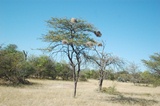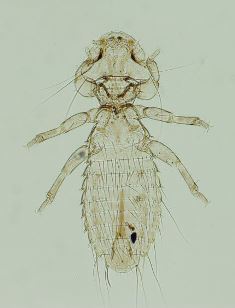Weaver news
| Sychra O, Halajian A, Luus-Powell W, Engelbrecht D, Symes C, Papousek I. 2014. Amblyceran chewing lice (Phthiraptera: Amblycera) from wild passerines (Passeriformes) in South Africa, with a note to their phylogenetic relationships and with the description of a new species in the genus Myrsidea. African Entomology 22(3):589-601.
Abstract. A total of 655 individuals of 110 passerine species belonging to 28 families were examined for chewing lice in South Africa. A total of 80 (12 %) birds of 33 species were parasitized with amblyceran chewing lice (Phthiraptera: Amblycera) belonging to three genera: Menacanthus, Myrsidea and Ricinus. In this paper we report the occurrence of 11 species of chewing lice identified from 38 birds of 16 species. Three samples of chewing lice containing only nymphs were identified to the generic level only. Description and illustrations are given for Myrsidea oatleyi Sychra & Halajian, sp. n. ex Pogonocichla stellata (Vieillot, 1818) (Muscicapidae). Our data represent the first louse records for Lanius collaris Linnaeus, 1766 (Laniidae), Cossypha dichroa (Gmelin, 1789) and Pogonocichla stellata (Muscicapidae), and Andropadus importunus (Vieillot, 1818) and Chlorocichla flaviventris (A. Smith, 1834) (Pycnonotidae). Records of new host-louse associations are: Cecropis abyssinica (Guérin-Meneville, 1843) (Hirundinidae) for Myrsidea rustica (Giebel, 1874); Cossypha dichroa (Muscicapidae) for Ricinus mugimaki (Uchida, 1915); Lanius collaris (Laniidae) for Menacanthus camelinus (Nitzsch [in Giebel], 1874); Ploceus intermedius Ruppell, 1845 (Ploceidae) for Myrsidea textoris Klockenhoff, 1984; and Prinia flavicans (Vieillot, 1820) (Cisticolidae) for Menacanthus curuccae (Schrank, 1776). A portion of the mitochondrial cytochrome oxidase I (COI) gene for some species of chewing lice was sequenced in order to assess their genetic divergences. The authors conducted fieldwork from December 2005 to December 2012 at 22 study sites in the following provinces of South Africa: Gauteng, KwaZulu-Natal, Limpopo, Mpumalanga, Northern Cape and the Western Cape. Host parasite relationships for 7 weavers are mentioned: White-browed Sparrow-weaver Plocepasser mahali
Literature as featured in Weaver Watch news items |











